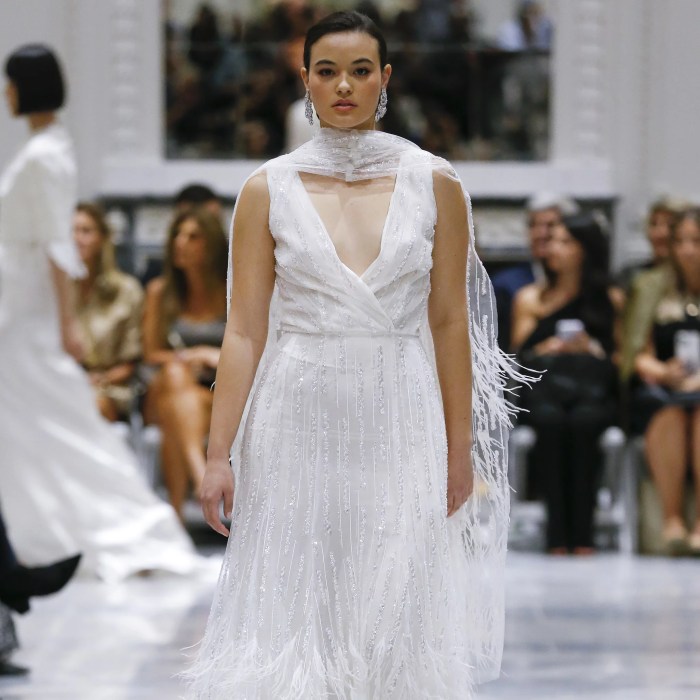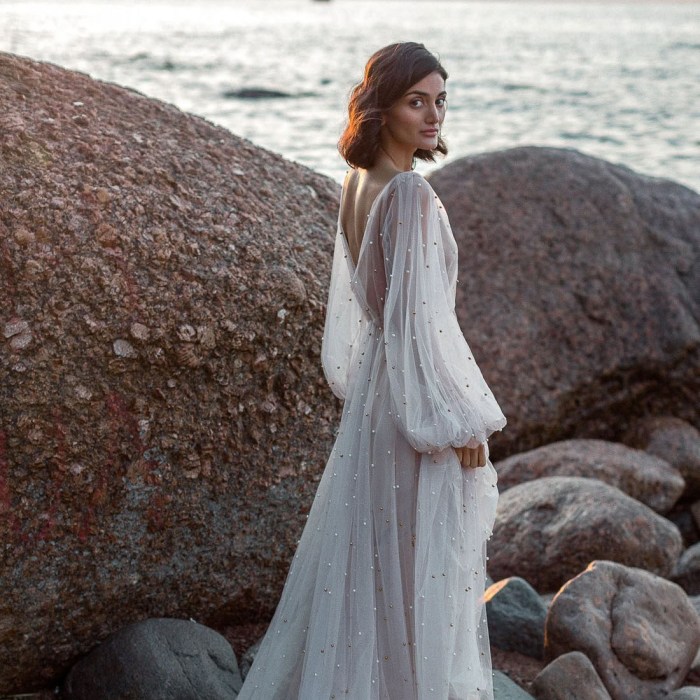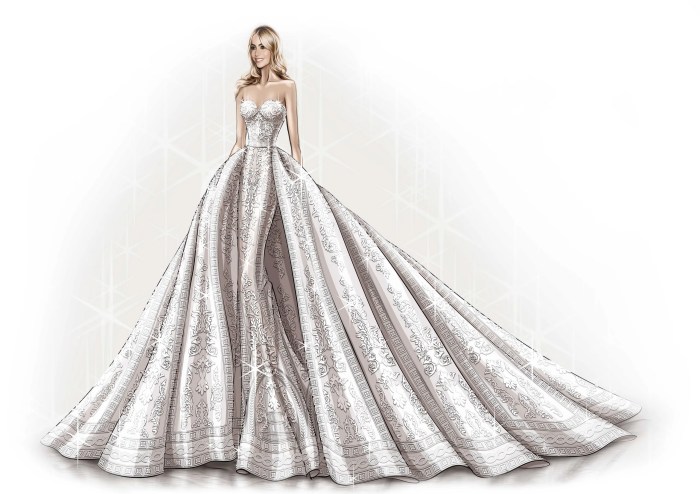Decoding the Dream: A Deep Dive into Wedding Dress Components
Parts of the wedding dress – From the flowing silhouette to the delicate embellishments, a wedding dress is more than just fabric; it’s a masterpiece of artistry and craftsmanship, a reflection of the bride’s personality and the celebration’s style. This exploration delves into the key components that contribute to the magic of a wedding gown, offering insights into the design, construction, and aesthetic impact of each element.
Wedding Gown Silhouettes

Source: popsugar-assets.com
The silhouette of a wedding dress sets the foundation for its overall look and feel. Different silhouettes flatter different body types and create distinct aesthetics. Understanding these options is crucial in finding the perfect dress.
| Silhouette | Description | Image Description |
|---|---|---|
| A-Line | Fitted at the shoulders and gradually widening towards the hem, creating a flattering “A” shape. This silhouette is universally flattering. | A classic A-line gown features a fitted bodice that gracefully flares out from the waist, creating a balanced and elegant silhouette. The skirt falls smoothly to the floor, often with a slight train. |
| Ballgown | Features a fitted bodice and a full, voluminous skirt, often made with layers of tulle or other fabrics. This creates a fairytale-like appearance. | A ballgown showcases a dramatic, full skirt that creates a princess-like effect. The bodice can be fitted or slightly loose, depending on the design, but the emphasis is on the expansive skirt. Often paired with a fitted bodice. |
| Mermaid | Fitted from the shoulders to the knees or mid-thigh, then flares out dramatically, resembling a mermaid’s tail. This silhouette is ideal for showcasing curves. | A mermaid gown hugs the body closely from the shoulders to the knees or mid-thigh, before flaring out into a dramatic, fishtail-like hem. This style accentuates the waist and hips. |
| Sheath | A simple, form-fitting silhouette that skims the body from shoulders to hem. This style is sleek and modern. | A sheath dress is characterized by its streamlined, close-fitting silhouette. It is usually straight and narrow, with minimal embellishments, highlighting the bride’s figure. |
| Empire Waist | Fitted just below the bust and flows loosely to the floor. This style is comfortable and flattering for various body types. | An empire waist gown features a high waistline that sits just below the bust, creating a flowing, relaxed silhouette from there to the floor. This style is often chosen for its comfortable and flattering fit. |
Wedding Dress Fabrics

Source: greenweddingshoes.com
The choice of fabric significantly impacts the drape, texture, and overall feel of a wedding dress. Each fabric offers unique qualities and aesthetic effects.
- Lace: Delicate and intricate, lace adds a romantic and elegant touch. It comes in various patterns and textures.
- Satin: Known for its smooth, luxurious sheen and elegant drape, satin creates a sophisticated and glamorous look.
- Silk: A luxurious and naturally beautiful fabric, silk drapes effortlessly and has a subtle sheen. It’s known for its breathability.
- Tulle: A lightweight, sheer netting often used to create volume and texture in skirts and veils.
- Chiffon: A lightweight, sheer fabric with a soft drape, chiffon is often used for overlays and flowing details.
Wedding Dress Construction Techniques
Creating a wedding dress is a complex process involving intricate construction techniques. Understanding these techniques helps appreciate the artistry involved.
Seams are the foundation, holding the fabric together. Darts shape the garment to the body. Boning provides structure and support, especially in bodices. These techniques, along with others like gathering, pleating, and ruching, create the final form and drape of the dress.
Wedding Dress Trains, Parts of the wedding dress
The train adds drama and elegance to a wedding dress, enhancing its overall aesthetic. The length of the train significantly influences the look and feel of the gown.
- Chapel Train: Extends to the floor and sweeps behind the bride, approximately 1-2 feet long.
- Cathedral Train: A long and dramatic train, extending several feet behind the bride, often seen in grand weddings.
- Court Train: Longer than a chapel train but shorter than a cathedral train, typically around 3-4 feet long.
- Royal Train: The longest train style, extending many feet behind the bride, adding a regal and extravagant touch.
A longer train adds grandeur and formality, while a shorter train offers more practicality and movement. The train’s length should be chosen to complement the venue and the overall style of the wedding.
Train Design Examples:
1. Detachable Train: A long train that can be removed for the reception, allowing for ease of movement. Suitable for various venues.
2. Sweep Train with Lace Overlay: A short train with a delicate lace overlay adds elegance without sacrificing practicality. Ideal for smaller venues or outdoor settings.
3. Cathedral Train with Button Detailing: A long cathedral train with intricate button detailing adds a touch of sophistication and personalization. Perfect for grand ballrooms or churches.
Wedding Dress Necklines and Sleeves
The neckline and sleeves are defining features that contribute significantly to the overall style and aesthetic of a wedding dress. These elements can flatter different body types and create diverse looks.
| Neckline | Description |
|---|---|
| Sweetheart | A curved neckline that resembles the shape of a heart, often flattering on most body types. |
| V-Neck | A V-shaped neckline that elongates the neck and torso, ideal for brides with a longer neck. |
| Halter | A neckline that ties or straps around the neck, often showing off the shoulders and back. |
| Off-the-Shoulder | A neckline where the fabric falls off the shoulders, creating a romantic and elegant look. |
| Bateau | A high, boat-shaped neckline that skims the collarbone, flattering on brides with broad shoulders. |
Sleeve Styles:
- Long Sleeves: Add elegance and sophistication, suitable for formal weddings or colder seasons.
- Short Sleeves: Offer a balance of coverage and style, suitable for various wedding styles.
- Cap Sleeves: Short sleeves that cover the upper arm, adding a touch of whimsy or elegance.
- Sleeveless: Showcases the shoulders and arms, ideal for warmer weather or more modern aesthetics.
Necklines and sleeves can be chosen to complement different body types. For example, a V-neck can elongate the torso, while off-the-shoulder styles can flatter broader shoulders.
Wedding Dress Embellishments

Source: vogue.com
From the intricate beading on the bodice to the flowing train, a wedding dress comprises numerous elements. Understanding these components helps guests choose appropriate attire, especially when considering the seasonal context; for October nuptials, a quick browse of options like those found at october wedding dresses for guests can be invaluable. Ultimately, the overall effect of the dress, much like a guest’s outfit, depends on the harmonious interplay of its individual parts.
Embellishments add personality and visual interest to a wedding dress, elevating its design and enhancing its overall impact.
Beading, embroidery, appliqués, and lace are common embellishments. Beading adds sparkle and shine; embroidery offers intricate detailing; appliqués create three-dimensional texture; and lace provides delicate elegance. The placement and type of embellishment significantly impact the overall look.
Example Embellishment Design:
A wedding dress could feature delicate beading along the neckline and straps, intricate embroidery on the bodice, and strategically placed lace appliqués along the skirt’s hemline. This combination creates a cohesive and visually stunning effect, balancing sparkle, detail, and delicate texture.
Wedding Veils and Accessories
Veils and accessories complete the wedding look, adding finishing touches and enhancing the overall design. These elements add personality and flair to the bridal ensemble.
- Cathedral Veil: A long veil that extends to the floor or even beyond, adding drama and elegance.
- Blusher Veil: A short veil that covers the face, often lifted during the ceremony.
- Birdcage Veil: A short, retro-inspired veil that frames the face.
| Accessory | Description |
|---|---|
| Headpieces | Tiaras, hair combs, or floral crowns add a touch of glamour or romanticism. |
| Jewelry | Necklaces, earrings, and bracelets complement the dress and add personal style. |
| Belts | Define the waist and add a touch of elegance or sparkle. |
| Shoes | Complete the look and should complement the dress and overall style. |
Veils and accessories should complement the wedding dress and the bride’s personal style. A simple dress might be paired with a statement headpiece, while a heavily embellished dress might call for simpler accessories.
FAQ Insights: Parts Of The Wedding Dress
What is the difference between a chapel and a cathedral train?
A chapel train extends to the floor, sweeping behind the bride for a few feet. A cathedral train is much longer, often extending several feet behind the bride, creating a more dramatic effect.
How do I choose the right neckline for my body type?
Consider your body shape. V-necks flatter most figures, while sweetheart necklines accentuate a fuller bust. Off-the-shoulder necklines suit a variety of body types and add a touch of elegance.
What are some less traditional veil options?
Consider a birdcage veil for a vintage look, a mantilla veil for a more romantic style, or even skip the veil altogether for a modern feel.
Can I add embellishments to a simpler dress?
Absolutely! Adding beading, lace appliqués, or embroidery can transform a plain gown into a stunning statement piece. Consult with a seamstress for expert advice.
